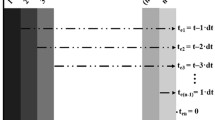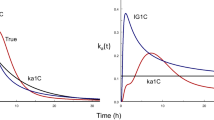Abstract
A simple method is proposed to estimate the total body clearance and biological half-life of drugs in patients by determining two blood or plasma levels of drugs separated by an appropriate interval during the constant-rate intravenous infusion. The method is based on the assumptions that the drug disposition in the body can be adequately described by the linear onecompartment open model and its apparent volume of distribution can be estimated with a reasonable degree of accuracy from the literature data. The validity of this newly proposed method was demonstrated in three rabbits using theophylline as a test drug. Results of theoretical error analyses indicate that the method is potentially useful in providing an early guide for dosing adjustments for those potent drugs whose elimination rates have been shown to vary greatly in patients. The method may be particularly useful in patients with changing elimination kinetics of drugs. Effects of the accuracy in Vd estimate, plasma level assay, and sampling time interval on the error of total body clearance estimation are discussed.
Similar content being viewed by others
References
J. W. Jenne, E. Wyze, F. S. Rood, and F. M. MacDonald. Pharmacokinetics of theophylline: Application to adjustment of the clinical dose of aminophylline.Clin. Pharmacol. Ther. 13:349–360 (1972).
P. A. Mitenko and R. I. Ogilvie. Rational intravenous dose of theophylline.New Engl. J. Med. 289:600–603 (1973).
G. Levy. Pharmacokinetic control of theophylline therapy. In G. Levy (ed.),Clinical Pharmacokinetics: A Symposium, APhA, Washington, D.C., 1974, pp. 103–110.
J. R. Powell, S. Vozeh, P. C. Hopewell, J. Costello, L. Sheiner, and S. Riegelman. Theophylline clearance in acutely ill patients with asthma and chronic obstructive pulmonary disease with and without congestive heart failure and pneumonia. InAbstracts, 124th APhA Annual Meeting, New York, May 14–19, 1977, p. 155.
T. R. Kordash, R. G. Van Dellen, and J. T. McCall. Theophylline concentrations in asthmatic patients after administration of aminophylline.J. Am. Med. Assoc. 238:139–141 (1977).
M. Gibaldi and D. Perrier.Pharmacokinetics, Dekker, New York, 1975.
A. Goldstein, L. Aronow, and S. M. Kaiman.Principles of Drug Action: The Basis of Pharmacology, 2nd ed., Wiley Biomedical-Health Publication, New York, 1974, Chap. 4.
W. L. Chiou and F. H. Hsu. Pharmacokinetics of creatinine in man and its implications in the monitoring of renal function and in dosage regimen modifications in patients with renal insufficiency.J. Clin. Pharmacol. 15:427–434 (1975).
W. L. Chiou and F. H. Hsu. A new simple and rapid method to monitor the renal function based on pharmacokinetic consideration of endogenous creatinine.Res. Commun. Chem. Pathol. Pharmacol. 10:315–330 (1975).
L. Z. Benet. General treatment of linear mammillary models with elimination from any compartment as used in pharmacokinetics.J. Pharm. Sci. 61:536–541 (1972).
G. W. Peng, V. Smith, A. Peng, and W. L. Chiou. A rapid and sensitive method for determination of theophylline in plasma and saliva by high pressure liquid chromatography.Res. Commun. Chem. Pathol. Pharmacol. 15:341–350 (1976).
P. M. Loughnan, D. S. Sitar, R. I. Ogilvie, A. Eisen, Z. Fox, and A. H. Neims. Pharmacokinetic analysis of the disposition of intravenous theophylline in young children.J. Pediat. 88:874–879 (1976).
M. A. F. Gadalla, G. W. Peng, and W. L. Chiou. Pharmacokinetic studies of theophylline after intravascular and various dosage forms of intramuscular administration. InAbstracts, 124th APhA Annual Meeting, New York, May 14–19, 1977, p. 161.
J. R. Powell, J. F. Thiercelin, S. Vozeh, L. Sansom, and S. Riegelman. The influence of cigarette smoking and sex on theophylline disposition.Am. Rev. Resp. Dis. 116:17–23 (1977).
F. A. Chrzanowski, P. J. Niebergall, R. L. Magock, J. M. Taubin, and E. T. Sugita. Kinetics of intravenous theophylline.Clin. Pharmacol. Ther. 22:188–195 (1977).
J. H. Hall and F. A. Sarubbi. Gentamicin serum concentrations: Pharmacokinetic Predictions.Ann. Int. Med. 88:183–189 (1976).
R. J. Sawchuk, D. E. Zaske, R. J. Cipole, W. A. Wargin, and R. G. Strate. Kinetic model for gentamicin dosing with the use of individual patient parameters.Clin. Pharmacol. Ther. 21:362–369 (1977).
Author information
Authors and Affiliations
Rights and permissions
About this article
Cite this article
Chiou, W.L., Gadalla, M.A.F. & Peng, G.W. Method for the rapid estimation of the total body drug clearance and adjustment of dosage regimens in patients during a constant-rate intravenous infusion. Journal of Pharmacokinetics and Biopharmaceutics 6, 135–151 (1978). https://doi.org/10.1007/BF01117448
Received:
Revised:
Published:
Issue Date:
DOI: https://doi.org/10.1007/BF01117448




